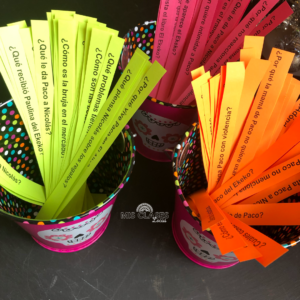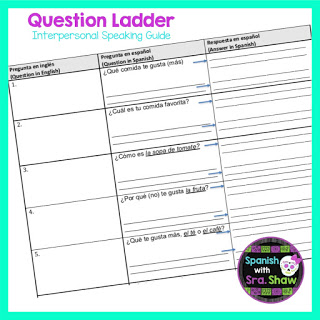
I have always found myself going back to the same types of speaking activities unit after unit, year after year. They’re easy for me to plan.
After a while though, kids eyes glaze over and they’re like, “Oh, we’re doing THIS activity again?” *insert teenagers rolling their eyes and looking as disinterested as possible*
If you’re looking for some fresh new ideas to broaden your teacher toolkit and include some variety in your lessons this year – look no further!
Here are 8 ideas for great speaking activities you can test out this school year for a variety of levels.
I have step-by-step directions here for how to create this type of speaking activity.
After a while though, kids eyes glaze over and they’re like, “Oh, we’re doing THIS activity again?” *insert teenagers rolling their eyes and looking as disinterested as possible*
If you’re looking for some fresh new ideas to broaden your teacher toolkit and include some variety in your lessons this year – look no further!
Here are 8 ideas for great speaking activities you can test out this school year for a variety of levels.
Info-Gap Partner Activity
My #1 fave go-to speaking activity is the info-gap partner activity. It takes a bit of prep work to make sure you set it up right, and you need to train kids well on how to do it, but once you’ve got those pieces in place - it’s smooth sailing.I have step-by-step directions here for how to create this type of speaking activity.
How does it work?
Give everyone a partner – I suggest you make everyone’s partner be the kid they’re sitting next to.Partner A has 5 questions and 5 answers on his paper. Partner B has question prompts for the 5 answers to Partner A’s questions and 5 questions that Partner A has answer prompts for.
Students alternate asking and answering questions with the prompts on their papers. They get speaking practice with a variety of the grammar or vocabulary that you are targeting that class period.
Question Ladders
Jen Shaw from Spanish with Sra Shaw suggests scaffolding students’ interpersonal speaking activities with question ladders. They can give lower-level students the support they need to successfully engage in conversation.Let’s say you’re teaching a food unit with stem-changing verbs. You give students the question “¿Qué prefieres comer para la cena?”.
Students then have to write a similar question in Spanish (most likely “¿Qué prefieres comer para el almuerzo?” or “Qué prefieres beber para la cena?”).
Then they have to answer both questions – your original question and the similar one they created.
You give them 5-6 question prompts for the unit, so students have 10-12 questions and answers that they can use in conversations.
Try it out
Ask & Switch
I like activities that get kids up and out of their seats. They spend almost the entire day seated. They need something active sometimes!
I have a blog post with step-by-step directions for how to create and use this activity here.
How does it work?
Everyone gets an index card with a question on one side and a prompt for an answer on the other.
Students get out of their seats and walk up to the partner of their choice.
Student A asks Student B the question on their index card and shows student B the answer prompt. Student B answers the question, asks Student A their question, Student A answers.
Then they switch cards and go find someone else to talk to. Ask. And. Switch.
Give kids 4-5 minutes so they get a variety of practice with questions and answers.

Students get a handout with a 4×4 grid on it. Each box has a question in it.
Try it out
I have Ask & Switch sets available in my TpT store for 20+ different grammar and vocabulary topics. Try the free version with the present tense form ir + places to see how it can work in your class!Find Someone Who
I have done this activity in my classroom, but I think Allison from Mis Clases Locas is the queen of this activity. Get her freebie here and read this Find Someone Who blog post and you can try it out in your class!
How does it work?
Students have to ask each other the questions in the boxes and find someone who did each activity.
They have to find a different person for each box!
This can be a great first-day mixer activity, or you can use it to target specific vocab or grammar structures.
They have to find a different person for each box!
This can be a great first-day mixer activity, or you can use it to target specific vocab or grammar structures.
Rotating Partners
There are maybe endless ways you can tweak this activity, but it’s the same general idea.
Students are divided into 2 groups and everyone in group 1 cycles through and speaks with everyone in group 2.
Well, it can work in a variety of ways.
Students are divided into 2 groups and everyone in group 1 cycles through and speaks with everyone in group 2.
How does it work?
Interview Style
Have half the kids stand at the front of the room (or wherever you have space) shoulder to shoulder (with some personal space between them) and their backs to the wall.
Then the other half of the students line up and face them. Everyone has a partner.
Partner A pretends to be a (pre-assigned) famous person (or a character from that novel your class just finished) and Partner B asks them questions.
You give them a predetermined amount of time. When the timer goes off, everyone takes two steps to their right and they have a new partner! Whoever is on the far right end then goes down to the end of the line.
You can have students switch roles so that everyone gets to ask and answer questions.
Speed Dating
Allow the entire class 30 seconds to finish awkwardly giggling at the name of this activity. Erin from The Engaged Spanish Classroom explains this activity with step-by-step directions and a free version you can download.
Rotating Partner Conversations
Allison from Mis Clases Locas has her students discuss a pre-determined topic and then move to a new chair with a new partner after the timer goes off.
It’s basically the same as speed dating, but without the name that makes teenagers awkwardly giggle uncontrollably.
Inside-Outside Circles
You need to have enough space in your classroom for half your students to stand in a large circle, with the other half of your class facing them in an inner circle.
Students ask each other questions and then the outer circle takes a step to the right after your timer goes off and they get a new partner.
This is not an ideal activity if your classroom is packed to the brim with 36 student desks and chairs and you have a minor meltdown when they put a 37th student in your class with no warning and you yell at your department head, “WHERE IS THIS CHILD GOING TO SIT?” #truestory
This is not an ideal activity if your classroom is packed to the brim with 36 student desks and chairs and you have a minor meltdown when they put a 37th student in your class with no warning and you yell at your department head, “WHERE IS THIS CHILD GOING TO SIT?” #truestory
Turn & Talk
If you were hoping for a speaking activity that integrates culture – girl, I’ve got you.How does it work?
Super Señora has her students speak at their tables or with partners about images that she shows (see the example above). They can discuss their thoughts on the image in small groups and then she can model questioning and answers to the whole class.
There are step-by-step directions for this activity here.
And drink hot chocolate while teaching.
Jen Ries guest blogs on Allison’s Mis Clases Locas blog to explain all the details. This activity is geared toward upper-level students who have enough Spanish to be able to carry on a full conversation.
Café y Conversación
This one might be my favorite idea. Bribe your students with delicious beverages. Transform your classroom into a café and bring that authentic culture to your students.And drink hot chocolate while teaching.
How does it work?
Pick a topic that students care about and is controversial to them. Or come up with a few topics and let them vote.
Students can prep for this by jotting down ideas, but it should be authentic and spontaneous Spanish, so their notes should be in English.
Students carry on a conversation in Spanish with the teacher as moderator to make sure kids aren’t talking over each other and are getting their turn to put in their 2 cents. Otherwise, it’s completely student-centered and student-driven conversation.
While you sip your tea and think about how many marshmallows you want in your hot chocolate next time.
Question Cards
Think like strips of paper. With questions on them.
Pretty straightforward.
Allison from Mis Clases Locas has a blog post about Questions Cards that breaks down types of questions and at least 5 different ways you can use them.

How does it work?
You can structure the activity in a variety of different ways (again, see Allison’s post for a zillion fab ideas), and include different types of questions, depending on what you’re teaching at that point.
What if I want to, like... grade these speaking activities?
Yeah… you might want to do that every once in a while.And by "grade" I mean throw points in every student's general direction as long as they're speaking Spanish.
Do you have any other speaking activities in your teacher toolbox? If you do, please share them in the comments!






 Insanely Easy Speaking Activities for Spanish Class: Manipulatives
Insanely Easy Speaking Activities for Spanish Class: Manipulatives 3 Tips to Make 1:1 Speaking Assessments EASY {with 30+ students}
3 Tips to Make 1:1 Speaking Assessments EASY {with 30+ students} Ask & Switch - A Speaking Activity
Ask & Switch - A Speaking Activity Insanely Easy Speaking Activities for Spanish Class: Whole-Class Speaking Activity
Insanely Easy Speaking Activities for Spanish Class: Whole-Class Speaking Activity
No comments
Post a Comment